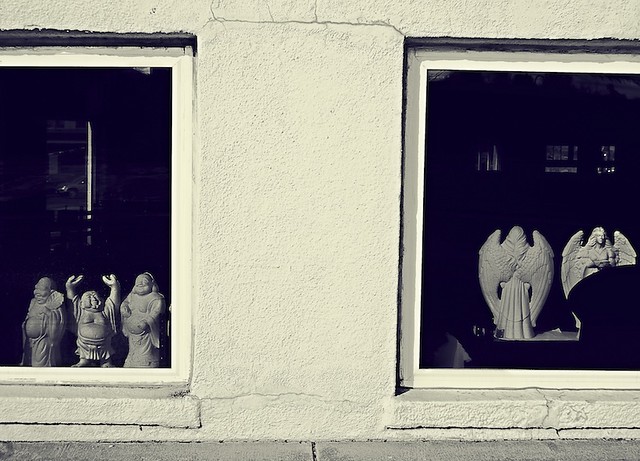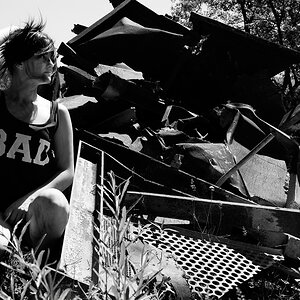how do you distinguish which image is breaking the rule of composition and which one is poorly composed? for example, if a image is followed by the rule of third, that count as a better composition. What if I just randomly place my subject off the points in rule of third, it looks pretty bad. in this situation does it count as breaking the rules?
Navigation
Install the app
How to install the app on iOS
Follow along with the video below to see how to install our site as a web app on your home screen.

Note: This feature currently requires accessing the site using the built-in Safari browser.
More options
You are using an out of date browser. It may not display this or other websites correctly.
You should upgrade or use an alternative browser.
You should upgrade or use an alternative browser.
composition?
- Thread starter Jason.C
- Start date
2WheelPhoto
TPF Noob!
- Joined
- Apr 14, 2011
- Messages
- 6,844
- Reaction score
- 996
- Location
- Tampa
- Can others edit my Photos
- Photos OK to edit
"There are no rules for good photographs, there are only good photographs" -Ansel Adams
unpopular
Been spending a lot of time on here!
I had a teacher once tell me to learn the rules of thirds and then forget them entirely. The point is, knowing about classical composition helps you realize intuitively when and how to use it.
dxqcanada
Been spending a lot of time on here!
- Joined
- Dec 4, 2008
- Messages
- 7,821
- Reaction score
- 1,673
- Location
- Woodbridge, Ontario, Canada
- Can others edit my Photos
- Photos OK to edit
The "rules" of composition where designed to make you see things outside the dead centre of the frame ... they are not the end.
rambler
No longer a newbie, moving up!
Here is an example. Suppose you have a dog running left to right across your photo. If his nose is right up against the right edge, he does not have anywhere to run so you put him in the opposite third and he now has all that space ahead of him to run into.
In the Nature Conservancy magazine is a photo of two turkey sized birds facing each other with their heads overlapping. It made a natural composition to leave them in the center, well-balanced, their heads reaching up and just in the upper half of the frame. It made nice lines leading upward forming a pyramid shape.Sometimes it is fine to have subjects centered.
Horizons usually work best when not in the center, a line across the middle of the frame. If the sky is dramatic, show mostly sky with the horizon line in the lower third. If it the foreground that is dynamic, have the horizon in the upper third.
However, if there is a dramatic reflection over quiet water, then it would be a nice composition to have the horizon line across the middle.
Someone wrote, if you go out of your way to break rules all the time that would be anarchy. If you never followed rules that would be chaos. So, most of the time follow the rules. Look at photos that please you and then analyze their composition.
In his book, "Photographically Speaking", David duChemin does just that. He critiques the composition of 21 of his photos.
In one of his photos he points out how it is not a very good composition, yet one that tells a moving story. He had to hurry to catch the moment, and it survived the broken rules.
Think of a stop sign near your home. The rule says you must come to a complete stop before moving on through. Hopefully, most of the time you do. Yet, other times you only come to a "rolling stop". And, I would be disappointed if you always got arrested for doing so. If you roared on through all the time, I would hope you would be arrested. See my point?
One more point about duChemin's book. He shows examples of the same image taken at different angles and views to help show you why he chose the final image as his choice. Photography magazines often do the same. Keep looking!
In the Nature Conservancy magazine is a photo of two turkey sized birds facing each other with their heads overlapping. It made a natural composition to leave them in the center, well-balanced, their heads reaching up and just in the upper half of the frame. It made nice lines leading upward forming a pyramid shape.Sometimes it is fine to have subjects centered.
Horizons usually work best when not in the center, a line across the middle of the frame. If the sky is dramatic, show mostly sky with the horizon line in the lower third. If it the foreground that is dynamic, have the horizon in the upper third.
However, if there is a dramatic reflection over quiet water, then it would be a nice composition to have the horizon line across the middle.
Someone wrote, if you go out of your way to break rules all the time that would be anarchy. If you never followed rules that would be chaos. So, most of the time follow the rules. Look at photos that please you and then analyze their composition.
In his book, "Photographically Speaking", David duChemin does just that. He critiques the composition of 21 of his photos.
In one of his photos he points out how it is not a very good composition, yet one that tells a moving story. He had to hurry to catch the moment, and it survived the broken rules.
Think of a stop sign near your home. The rule says you must come to a complete stop before moving on through. Hopefully, most of the time you do. Yet, other times you only come to a "rolling stop". And, I would be disappointed if you always got arrested for doing so. If you roared on through all the time, I would hope you would be arrested. See my point?
One more point about duChemin's book. He shows examples of the same image taken at different angles and views to help show you why he chose the final image as his choice. Photography magazines often do the same. Keep looking!
Last edited:
jodellny
TPF Noob!
- Joined
- Jan 3, 2012
- Messages
- 12
- Reaction score
- 0
- Location
- Greensboro, NC
- Can others edit my Photos
- Photos NOT OK to edit
That the beauty of photography, it's your art. Whatever you want to shoot. Some will love it some will hate lol Can't please everyone
Greensboro Photographer
Joseph Bradley
Greensboro Photographer
Joseph Bradley
- Joined
- Jul 8, 2005
- Messages
- 45,747
- Reaction score
- 14,806
- Location
- Victoria, BC
- Website
- www.johnsphotography.ca
- Can others edit my Photos
- Photos OK to edit
Shoot what you like? Absolutely.Shoot what you like, forget the rules and make the composition you like
Forget the rules of composition? NO!!
Make the composition you like? Yes, but with considerations for the rules of composition.
The reason that compositional guidelines have evolved is because it is a fact that most people find certain types of composition more pleasing than others. Granted, for every occasion when they work, there is at least one when they don't, BUT, a knowledge of photographic composition (which is a LOT more than just the rule of thirds) is essential in helping to understand what makes a good photograph to most people.
Joey_Ricard
TPF Noob!
- Joined
- Dec 22, 2011
- Messages
- 672
- Reaction score
- 69
- Location
- West Virginia
- Can others edit my Photos
- Photos NOT OK to edit
Rule, suggestion, guideline (of thirds) or whatever you want to call it today - should be observed if you are attempting to create a balanced image that is aesthetically pleasing and symmetrical to most viewers. Of course photography is subjective to it's intended audiences and an unbalanced image surely stands out.
I hate the word "rule" and I could see where someone new to photography would drive themselves nuts thinking about it for every shot they take. I say, there is no right or wrong, but there is "what looks pleasing" And of course, that depends on who is viewing it (you or someone else).
Take the time before you shoot and visualize the overall balance and don't rush yourself, while observing "the rule" or "what looks pleasing".
Then, step back, review your shot and shoot again if needed.
In my book lol, there is no rule of composition, but more of a visualization of balance, and like Tirediron said "what makes a good photograph to most viewers".
I hate the word "rule" and I could see where someone new to photography would drive themselves nuts thinking about it for every shot they take. I say, there is no right or wrong, but there is "what looks pleasing" And of course, that depends on who is viewing it (you or someone else).
Take the time before you shoot and visualize the overall balance and don't rush yourself, while observing "the rule" or "what looks pleasing".
Then, step back, review your shot and shoot again if needed.
In my book lol, there is no rule of composition, but more of a visualization of balance, and like Tirediron said "what makes a good photograph to most viewers".
Forkie
Been spending a lot of time on here!
- Joined
- Feb 14, 2011
- Messages
- 2,292
- Reaction score
- 920
- Location
- Chiswick, London, UK
- Website
- www.ianforknall.com
- Can others edit my Photos
- Photos NOT OK to edit
There's a difference between breaking the rules and not knowing the rules. You definitely need to understand the rules to be able to break them effectively.
Bitter Jeweler
Been spending a lot of time on here!
- Joined
- Apr 27, 2009
- Messages
- 12,983
- Reaction score
- 4,993
- Location
- Cleveland, Ohio
- Can others edit my Photos
- Photos OK to edit
That the beauty of photography, it's your art. Whatever you want to shoot. Some will love it some will hate lol Can't please everyone
Shoot what you like, forget the rules and make the composition you like
Just go with what you think looks good.
Why do people perpetuate this garbage?
- Joined
- Apr 9, 2009
- Messages
- 41,401
- Reaction score
- 5,706
- Location
- Iowa
- Website
- kharrodphotography.blogspot.com
- Can others edit my Photos
- Photos OK to edit
Humans have been doing visual art for several thousand years now.
In that time it has become very apparent some compositional techniques just work better than others.
Some lighting techniques, just work better than others.
You can study the compositional guidelines that have repeatedly demonstrated over the last couple of thousand years that they work the vast majority of the time.
OR
You can stumble along and recreate a very small portion of that several thousand years of trial and error, in your lifetime. :er:
In that time it has become very apparent some compositional techniques just work better than others.
Some lighting techniques, just work better than others.
You can study the compositional guidelines that have repeatedly demonstrated over the last couple of thousand years that they work the vast majority of the time.
OR
You can stumble along and recreate a very small portion of that several thousand years of trial and error, in your lifetime. :er:
unpopular
Been spending a lot of time on here!
Rule, suggestion, guideline (of thirds) or whatever you want to call it today - should be observed if you are attempting to create a balanced image that is aesthetically pleasing and symmetrical to most viewers. Of course photography is subjective to it's intended audiences and an unbalanced image surely stands out.
I agree 100% "Harmony" was not at all what I was going for with this image:

rexbobcat
Been spending a lot of time on here!
- Joined
- Nov 28, 2011
- Messages
- 5,014
- Reaction score
- 1,967
- Location
- United States
- Can others edit my Photos
- Photos OK to edit
They're not really rules, as much as they are guidelines in my opinion.
Similar threads
- Replies
- 7
- Views
- 2K
- Replies
- 9
- Views
- 228
- Replies
- 6
- Views
- 413
- Replies
- 11
- Views
- 635




![[No title]](/data/xfmg/thumbnail/39/39438-1eb8b5f82b59d9d0c72ae9025778ed4c.jpg?1619739032)







